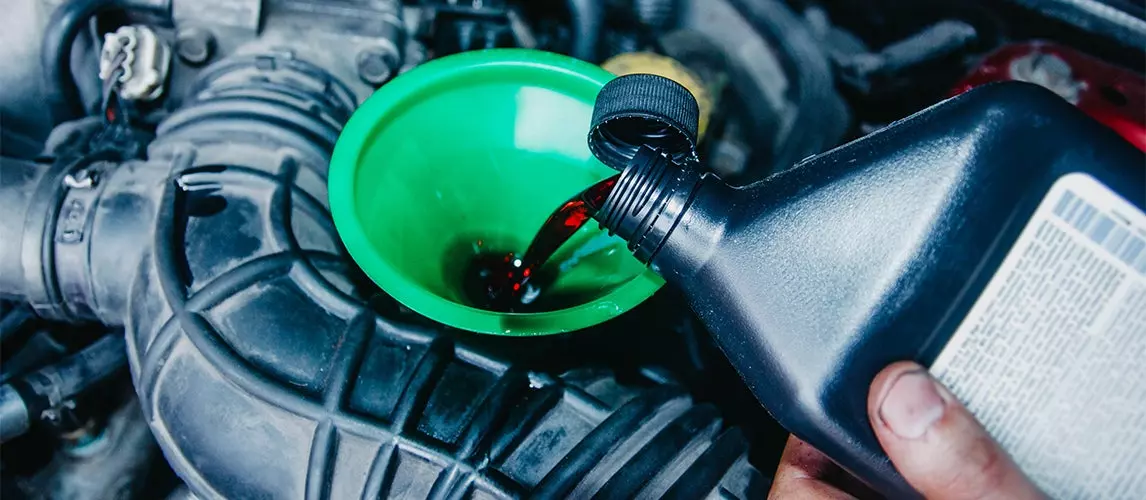Transmission fluid is like the Ronco Rotisserie; it’s a car fluid that is set and filled at the factory and quickly forgotten. Yet, your transmission fluid is as vital as your engine oil and ensures that you’re not sweeping up clutch shrapnel. That would be what we call in the industry, “A Not Good DayTM.”
Keeping a watchful eye on your transmission fluid, however, isn’t a monumental task, nor does it need be an everyday occurrence. In fact, you really only need to check your transmission fluid once a year. That said, if the time since your last transmission fluid check is “a while” to “never,”, you might have a horror show waiting for you.
So let’s prepare you for what you might see if you don’t change your transmission fluid regularly.
What Is Transmission Fluid?
Transmission fluid is the viscous oil that allows the transmission to function without failure. In addition to lubricating the transmission’s internals, the fluid prevents heat build-up and metal-on-metal. Each transmission fluid features brand-specific properties needed for the gearbox to function properly, as well. Transmission fluid is typically colored red or green to help DIYers distinguish it from conventional motor oil.
When To Change Transmission Fluid (And What Happens If You Don’t)?
Most manufacturers recommend that manual transmission fluid be changed every 30,000 to 60,000 miles. Under heavy-duty use, some manufacturers suggest changing transmission fluid every 15,000 miles.
You know when Wile E. Coyote sees a tunnel but slams into the side of a mountain in the blink of an eye? Yeah, that sort of arresting stoppage of momentum could occur. Here’s why.
Most transmission fluid can last up to 100,000 miles, with a handful designed with higher limits.
We recommended you change your fluid at 100,000 miles or close to it, depending on the level of abuse, old transmission fluid could seize internals, evaporate, seep out, and cause catastrophic transmission failure while driving down the road. So if you don’t want to be out a couple thousand dollars, it’s best you check your transmission fluid from time to time.
That said, some modern vehicles make things complicated with sealed transmission systems that feature sensors to tell you when it’s time to flush your fluid. These cars don’t have a traditional transmission fluid dipstick like older ones. You’ll need to root around your engine bay or ask your dealership if your car has one or not.
How Do I Know Whether to Flush or Change the Transmission Fluid?
Is your transmission fluid dark brown or sludgy? Is your transmission hiccuping, stalling, or jerking you around like a bucking bronco? Is a little light or infotainment notification directly telling you it’s time? Well, fine sir or madam, it’s time to change that fluid!
How Do I Add Transmission Fluid?
Most cars have a transmission fluid dipstick that displays the fluid levels. Using this information and a funnel, pour the fluid into the unit. For those for more info, you can follow along with Car Autance’s How To Properly Add Fluid to an Automatic Transmission.
What Happens If You Use the Wrong Transmission Fluid?
If you accidentally add power steering fluid, you should be fine, as power steering fluid and automatic transmission fluid are similar in their chemical compositions. If you accidentally put in motor oil, well, that’s a far worse place to be and could cause your transmission to fail. Don’t do that.
What Are The Symptoms of Low Transmission Fluid?
Not adding enough, or if your transmission is leaky or weeping fluid, can also be massively detrimental to the life of your transmission. If your transmission fluid is low, you may experience unexpected shifts, both up and down, as well as metal grinding noises, overheating, rpm spikes, and the inability to shift the car into gear.
Before flushing your car’s transmission fluid, consult your dusty manual or online to find out exactly how much transmission fluid you need. That’ll save you a headache later on.
How Much Does It Cost To Change Transmission Fluid?
If you have a dealership or mechanic do the transmission fluid flush for you, you’re looking at a range of $80-$250. DIYers will have considerably smaller bills, ranging from $25-$50 depending on how much fluid your car takes.
Can I Add Too Much Transmission Fluid?
Yes! You can add too much transmission fluid and it could prove unsafe as the fluid could weep out of the transmission and catch fire. You could also experience sluggish shifts, increased transmission fluid pressure, overheating, and inevitably, failure. You can read Car Autance’s more in-depth article about all the effects and issues that could arise when you add too much transmission fluid.
What’s the Difference Between Automatic and Manual Transmission Fluid?
Though you’d expect vast differences between the two—they are, after all, used for very different applications—there really isn’t much. Past manual transmission fluid compositions were thicker fluids, more resembling cold honey. But as manual-equipped cars have become rarer, manufacturers have primarily switched to using automatic transmission fluid. This allows for easier shifts, is better for cold-weather operation, and costs the manufacturer less in terms of maintenance and production.
The biggest difference between automatic and manual transmission fluid is the manufacturer-recommend change or flush mileage. While automatics can last up to 100,000 miles, most manual transmissions require fluid changes every 30,000-60,000 miles due to increased usage and abuse. That said, Ford’s Mustang GT350 only requires a fluid change every 150,000 miles, so you’ll need to check your car’s manual to see what the manufacturer’s recommendations are.









